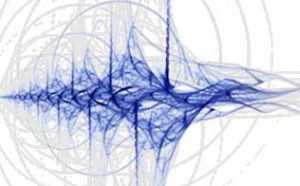Charles Choi, LiveScience
Some people may actually see sounds, say researchers who found this odd ability is possible when the parts of the brain devoted to vision are small.
These findings points to a clever strategy the brain might use when vision is unreliable, investigators added.
Scientists took a closer look at the sound-induced flash illusion. When a single flash is followed by two bleeps, people sometimes also see two illusory consecutive flashes.
Past experiments revealed there are strong differences between individuals when it comes to how prone they are to this illusion. “Some would experience it almost every time a flash was accompanied by two bleeps, others would almost never see the second flash,” said researcher Benjamin de Haas, a neuroscientist at University College London.
These differences suggested to de Haas and his colleagues that maybe variations in brain anatomy were behind who saw the illusion and who did not. To find out, the researchers analyzed the brains of 29 volunteers with magnetic resonance imaging (MRI) and tested them with flashes and bleeps. [Animation of Illusion and Photos of Other Illusions]
On average, the volunteers saw the illusion 62 percent of the time, although some saw it only 2 percent of the time while others saw it 100 percent of the time. They found the smaller a person’s visual cortex was — the part of the brain linked with vision —the more likely he or she experienced the illusion.”If we both look at the same thing, we would expect our perception to be identical,” de Haas told LiveScience. “Our results demonstrate that this not quite true in every situation — sometimes what you perceive depends on your individual brain anatomy.”
The researchers suggest this illusion could reveal a way the brain compensates for imperfect visual circuitry.
“The visual brain’s representation of what hits the eye is very efficient but not perfect — there is some uncertainty to visual representations, especially when things happen quickly, like the rapid succession of flashes in the illusion,” de Haas said. “We speculate that this kind of uncertainty is bigger in brains that dedicate a smaller proportion of neurons to visual areas, just like a camera with fewer megapixels will give you a lower image quality.”
“If this speculation holds, it would make perfect sense for smaller visual brains to make more use of the additional information provided by the ears,” de Haas explained. “In the real world, sources of light and sound are often identical, and combining them will be advantageous. Imagine you take a twilight walk in a forest and scare up some animal in the undergrowth. The best strategy for finding out whether you are dealing with a hedgehog or a bear will involve combining visual information, like moving twigs and branches, with auditory information, like cracking wood.”
Much remains unknown about the roots of this illusion. For instance, only about a quarter of the individual differences regarding the illusion could be explained by brain anatomy. “We still haven’t explained the rest,” de Haas said.
Future research can also explore “whether the relationship between visual cortex size and audiovisual perception is specific to this illusion or holds for other audiovisual illusions as well,” de Haas said.
Other such illusions include the so-called McGurk effect, when the visual component of one sound is paired with the auditory component of another sound, leading people to mysteriously perceive a third sound — for instance, when the syllables “ba-ba” are spoken over the lip movements for “ga-ga,” the perception is of “da-da.”
“Seeing feels like an objective, immediate way to access the world, but it can be shaped by so many things — hearing, individual brain anatomy, who knows what else?” de Haas said.
The scientists detailed their findings online Oct. 24 in the journal Proceedings of the Royal Society B.

If you've ever found value in our articles, we'd greatly appreciate your support by purchasing Mindful Meditation Techniques for Kids - A Practical Guide for Adults to Empower Kids with the Gift of Inner Peace and Resilience for Life.
In the spirit of mindfulness, we encourage you to choose the paperback version. Delve into its pages away from screen glare and notifications, allowing yourself to fully immerse in the transformative practices within. The physical book enriches the learning process and serves as a tangible commitment to mindfulness, easily shared among family and friends.
Over the past few years, Wake Up World has faced significant online censorship, impacting our financial ability to stay online. Instead of soliciting donations, we're exploring win-win solutions with our readers to remain financially viable. Moving into book publishing, we hope to secure ongoing funds to continue our mission. With over 8,500 articles published in the past 13 years, we are committed to keeping our content free and accessible to everyone, without resorting to a paywall.







